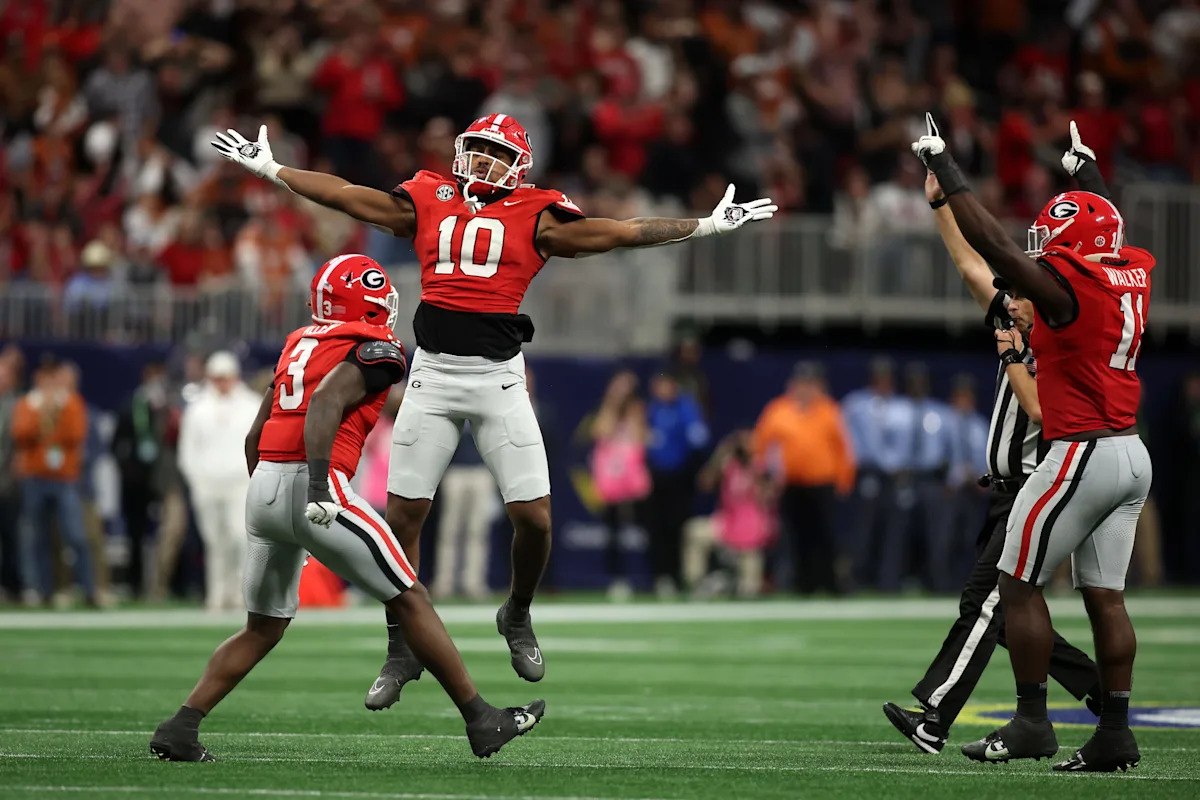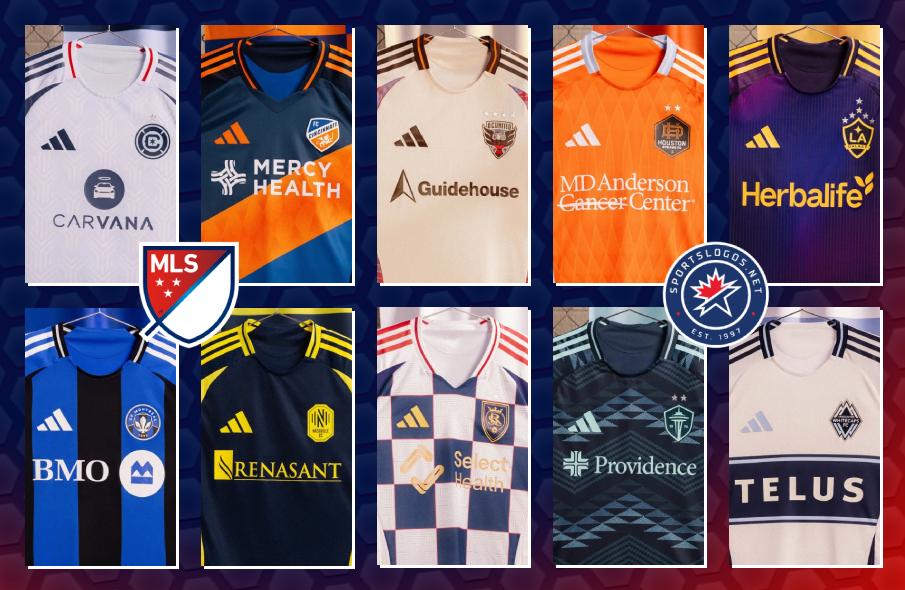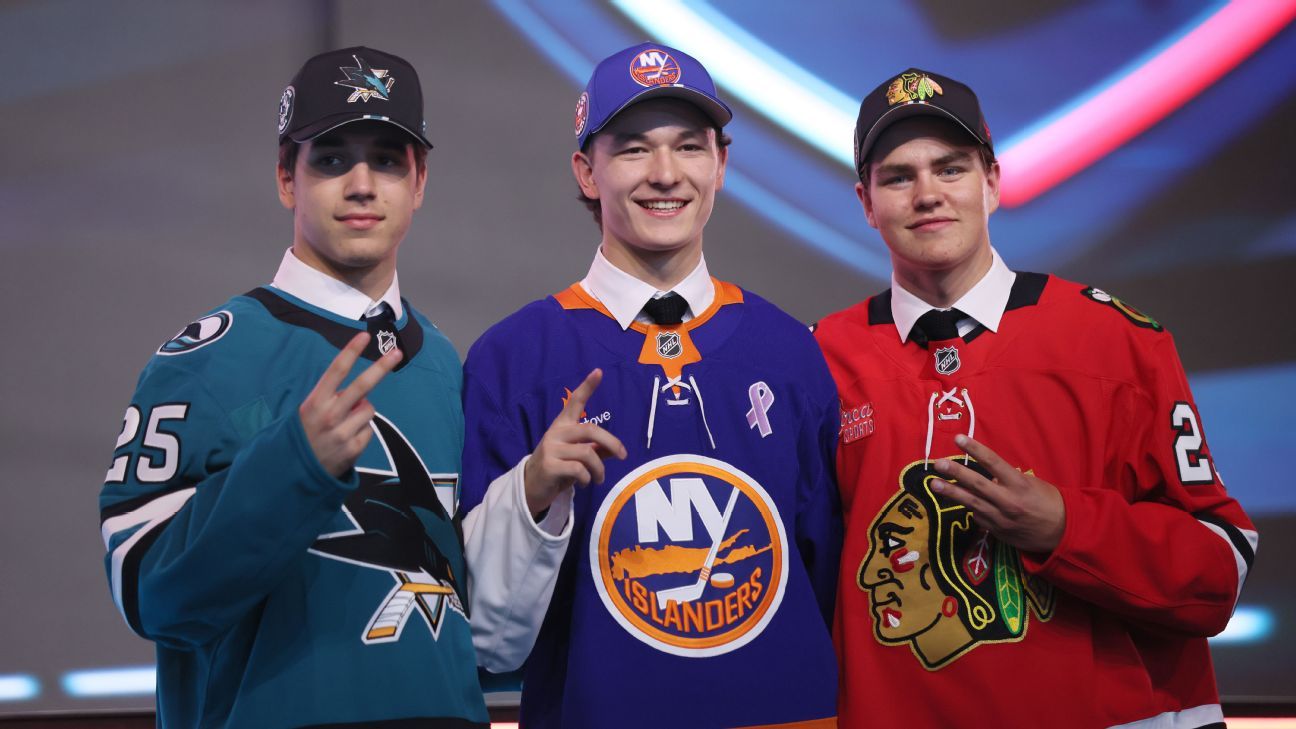College Sports
Oklahoma softball seeks 5-peat in Women’s College World Series
College World Series; Women’s College World Series; NFL OTAs | 2MD College baseball’s 64-team tournament is set to begin; the Women’s College World Series is down to 8 teams; Dolphins, Jaguars, Bucs OTAs. In the 2025 Women’s College World Series, Patty Gasso’s Oklahoma Sooners are looking to join some of the most rarified air in […]


College World Series; Women’s College World Series; NFL OTAs | 2MD
College baseball’s 64-team tournament is set to begin; the Women’s College World Series is down to 8 teams; Dolphins, Jaguars, Bucs OTAs.
In the 2025 Women’s College World Series, Patty Gasso’s Oklahoma Sooners are looking to join some of the most rarified air in collegiate team sports.
If Oklahoma manages to win the WCWS, which it enters as the top seed remaining (No. 1 overall Texas A&M was knocked out in the regional round), it would join UCLA men’s basketball in John Wooden’s heyday and USC baseball in the 1970s to become the only programs to win five or more straight national titles in one of the major team sports (football, men’s/women’s basketball, men’s/women’s ice hockey, baseball/softball).
While dominance of this magnitude has appeared in track & field and swimming, among other sum-of-their-parts sports, something about it feels different when it comes to team sports themselves. What the Sooners are doing also comes in the midst of a transitionary time for college athletics, which has also foisted some parity into NCAA competition.
Here is what to know as the Sooners chase their prestigious fifth straight national title, and who they would be joining at the pinnacle of college dynasties.
How many national championships has Oklahoma softball won?
In total, Oklahoma softball has won eight national titles, all under Gasso.
Half of those have come in the past four years, with Oklahoma winning in 2021, 2022, 2023, and 2024. 2025, if Oklahoma is able to win yet again, would mark the fifth straight year Oklahoma manages to win the Women’s College World Series. At this point, the Sooners are racing themselves. The previous record for consecutive national champions was three (UCLA, 1988-90) before Oklahoma became the first four-time winners by defeating Texas last season.
5-time repeat champions in college team sports
Patty Gasso is already the greatest softball coach of all time, but a fifth straight win would catapult her to a name nearly unrivaled in college athletics: The great John Wooden.
Wooden’s UCLA men’s basketball team won a staggering seven straight national titles from 1967-73, the only program in football, men’s/women’s basketball, men’s/women’s ice hockey, and baseball/softball to win more than four national titles in a row.
USC baseball under Rod Dedeaux is the other program to win five straight titles, when the Trojans took every national championship between 1970 and 1974. Dedeaux had 10 national titles during his USC tenure, and the Trojans now play at Dedeaux Field.
There have been more five-time champions in meet and heat sports, along with individual champions. But in the major team sports it’s an exceptionally rare achievement.
Pro sports teams to win five straight championships
Only two pro sports teams have won five straight titles, and both of those titles came in ages past.
The New York Yankees won five straight World Series from 1949-53, marking the only time this has happened in MLB history.
In the NHL, the Montreal Canadiens won five straight titles from 1956-60.
The Boston Celtics stand kings of the streak, with eight straight championships from 1959-66.
No NFL team has made the Super Bowl five times in a row, let alone won it. Nine teams have gone back-to-back, but no team has ever three-peated.
College Sports
5-star Georgia recruiting target signs major NIL deal in latest twist
Five-star linebacker recruit Tyler Atkinson has signed a significant name, image and likeness deal. Atkinson, who is ranked as the No. 1 linebacker prospect in the country, has signed as an NIL partner with Adidas. Atkinson is one of six class of 2026 recruits to reach a deal with Adidas. On3 recently gave Atkinson a […]

Five-star linebacker recruit Tyler Atkinson has signed a significant name, image and likeness deal. Atkinson, who is ranked as the No. 1 linebacker prospect in the country, has signed as an NIL partner with Adidas. Atkinson is one of six class of 2026 recruits to reach a deal with Adidas.
On3 recently gave Atkinson a $389,000 NIL valuation, but he has a chance to exceed that figure. The 6-foot-2, 210-pound linebacker is the top recruit in Georgia. Atkinson is the No. 8 recruit in the nation, per On3. He has an impressive combination of versatility, athleticism and production. The top college football programs across the country are willing to pay big dollars for what Atkinson brings to the table.
Advertisement
The Georgia Bulldogs are expected to land a commitment from Atkinson. The five-star is also considering the Texas Longhorns, Oregon Ducks and Clemson Tigers. Interestingly, all of Atkinson’s top contenders are Nike schools.
Wherever Atkinson ends up he should have an opportunity to make an instant impact as a true freshman. The class of 2026 linebacker led the way as Grayson won a Georgia 6A state championship in 2024.
Last year, Atkinson recorded 166 tackles, 13 sacks, an interception and a forced fumble. He played well in Grayon’s state title win and finished the game with 13 tackles and two sacks.
Follow UGAWire on Instagram or Threads!
This article originally appeared on UGA Wire: 5-star UGA football recruiting target Tyler Atkinson inks NIL deal
College Sports
Three Former College Players are on MLS' Top 10 Kit Sales List for 2025
Last week, Major League Soccer (MLS) released its top-selling jerseys for 2025, and three players in the top 10 were former college players. The Columbus Crew’s Darlington Nagbe came in at fifth. The Seattle Sounders’ Jordan Morris is ranked right behind in sixth, and Charlotte FC’s Patrick Agyemang is ranked ninth. Here is a breakdown […]



Last week, Major League Soccer (MLS) released its top-selling jerseys for 2025, and three players in the top 10 were former college players. The Columbus Crew’s Darlington Nagbe came in at fifth. The Seattle Sounders’ Jordan Morris is ranked right behind in sixth, and Charlotte FC’s Patrick Agyemang is ranked ninth.
Here is a breakdown of all three players’ college careers:
Darlington Nagbe – University of Akron
Darlington Nagbe is a college soccer legend with his junior year in 2010 being his most standout season. He finished that campaign with 20 goal contributions (7g/13a) and led Akron to their first-ever national championship in any sport. He was also an NSCAA First Team All-American and won the Missouri Athletics Club Hermann Trophy. He signed a Generation Adidas contract after that season and was selected second overall by the Portland Timbers in the 2011 SuperDraft.
Jordan Morris – Stanford University
Jordan Morris, like Nagbe, won all the top awards during his junior season. He was an NSCAA First Team All-American in 2015 and won the MAC Hermann Trophy that same year. He also helped lead the Cardinals to their first national championship in 2015. Morris finished his three-year career at Stanford with 52 starts and 39 goal contributions (23g/16a). Morris opted out of the draft and signed with the Sounders as a homegrown player.
Patrick Agyemang – University of Rhode Island
Patrick Agyemang’s college career differed significantly from those of Nagbe and Morris. He began playing college soccer in Division III before transferring to Rhode Island. In his Rhode Island career, Agyemang made 33 starts and had 31 goal contributions (19g/12a). He was named to the Atlantic 10 All-Conference First Team in 2021 and 2022. Charlotte FC selected Agyemang with the 12th pick in the 2023 SuperDraft.
College Sports
2025 NHL draft live updates: 7-round, 32-team pick tracker
Rachel DoerrieJun 27, 2025, 11:30 PM ET Close Rachel Doerrie is a professional data consultant specializing in data communication and modelling. She’s worked in the NHL and consulted for professional teams across North American and Europe. She hosts the Staff & Graph Podcast and discusses sports from a data-driven perspective. The 2025 NHL draft is […]

The 2025 NHL draft is taking place on Friday (Round 1) and Saturday (Rounds 2-7) at the Peacock Theater in Los Angeles.
This page will be your home for the entire event, as each pick is added below, including scouting notes and team fit analysis for the first-rounders.
More: Prospect rankings
Draft week buzz
Late-round gems
Needs for all 32 teams
Round 1

Team: Erie (OHL)
DOB: 09/05/2007 | Ht: 6-1¾ | Wt: 183 | Shot: L
2024-25 stats: GP: 17 | G: 7 | A: 15 | P: 22
Scouting notes: Schaefer is projected to become a true No. 1 cornerstone for years to come. A dynamic presence at both ends of the ice, he skates with ease and elite mobility to shut down opponents in all situations, while creating offense with quality transition play.
Executives and scouts view him as a future elite NHL defenseman and a foundational piece for a championship-caliber roster. Schaefer’s ability to control play from the blue line, play tough matchups, and run a power play — combined with the belief in his character and leadership — result in many believing that Schaefer has the tools to become a top-10 defender in the league, while wearing a letter as part of a team’s leadership group.
How he fits: After trading Noah Dobson earlier in the day, the Islanders drafted their franchise cornerstone defender. Schaefer does everything well, and is a dynamic skater with elite mobility. He will take on the toughest matchups, help the Islanders exit the zone with smooth passes and carry outs, and drive offense from the back end. He’s a future No. 1 defenseman who will log 25-28 minutes per night and run the power play.
Schaefer’s ability to dictate play from the back end is franchise-changing for the Isles. Schaefer will attend development camp next week, and it is highly likely he starts the season in the NHL lineup. Don’t be surprised if Schaefer is running the power play and logging major minutes by November.
A very emotional Schaefer hugged his family and pulled on the Isles jersey for the first time, with a cancer patch. Through tears, he shared his excitement and emotion, and gained the hearts of a lot more than just Isles fans.

Team: Saginaw (OHL)
DOB: 02/16/2007 | Ht: 6-¾ | Wt: 184 | Shot: L
2024-25 stats: GP: 65 | G: 62 | A: 72 | P: 134
Scouting notes: Granted exceptional status in the OHL in 2022, Misa delivered one of the most remarkable goal-scoring seasons in recent memory in 2024-25, netting 62 goals in just 65 games. He projects to be a top-line forward capable of consistently exceeding 90 points per season in the NHL.
Misa’s offensive instincts are elite. He processes the game at a high level and executes at top speed. Scouts believe he is NHL-ready and has the potential to become an elite top-line center. Away from the puck, Misa excels at finding soft areas in coverage and has a flair for delivering in clutch moments. His combination of high-end playmaking and goal-scoring ability makes him a constant dual threat in the offensive zone.
How he fits: The Sharks kept everyone guessing until the very last moment, but ultimately selected Misa. He is a special talent and adds a second elite two-way center to the organization. He projects as a first-line star, with dual-threat playmaking and scoring ability — notching 62 goals in 65 OHL games.
If Misa’s two-way game continues to improve, there’s a real chance the Sharks will have two centers capable of dominating play in all three zones with 2024 No. 1 pick Macklin Celebrini already in place. On the power play, Misa can facilitate, be a shooting threat and carry the puck on entries. Because of his dual-threat capabilities, he can play the bumper, the flank or down low. With this selection, the Sharks have the potential to feature the best one-two punch down the middle for years to come.

Team: Djurgarden (SWEDEN-2)
DOB: 05/07/2007 | Ht: 6-1 | Wt: 198 | Shot: L
2024-25 stats: GP: 29 | G: 11 | A: 14 | P: 25
Scouting notes: Frondell is a versatile two-way forward that plays both center and right wing. His flexibility is attractive to teams, although many believe he is most likely to reach his potential as a winger in the NHL.
Frondell is coming off one of the most productive seasons by an under-18 player in Allsvenskan history, giving him a confident projection as a first-line NHL forward. He’s a cerebral player, who picks apart defenders in one-on-one situations and defensive coverage in offensive zone play. The details of Frondell’s game are translatable, including excellent forechecking ability, willingness to attack the middle of the ice and high-end anticipation on both sides of the puck.
He has shown play-driving capabilities against men in the Allsvenskan, which has translated to the NHL for other prospects in the past. He’s projected to produce between 75-85 points per season. His style of play translates well and has executives excited about his ability to step in the league in the next 18 months.
How he fits: It was no secret that Chicago wanted to add some size up front, and Frondell is exactly that. He can play center or the wing, and brings an excellent two-way game. He confidently projects as a first-line forward that beats defenders one-on-one, drives play on both ends of the ice, and should score nearly a point per game.
He plays on the inside of the ice and has the ability to score 30-plus goals in the NHL because of his excellent shot. Frondell is a year away from playing in the NHL, and probably two or three from hitting his potential as a top-line forward who drives play. Chicago can play him behind Connor Bedard up the middle, or on Bedard’s line to capitalize on the versatility he brings.

Team: Moncton (QMJHL)
DOB: 04/11/2007 | Ht: 6-1½ | Wt: 178 | Shot: L
2024-25 stats: GP: 56 | G: 35 | A: 49 | P: 84
Scouting notes: Described as a “coach’s dream” because of his ability to take an offensive or checking assignment and execute consistently. He makes smart, simple plays, provides a physical presence on the forecheck and generally agitates and makes life difficult on defenders.
He projects to be a quality second-line center with a decent chance of becoming a first-line player. He’s cerebral, with quick hands and playmaking ability. He’s not flashy, but he’s consistently effective and makes intelligent plays with the puck. As one scouting director described “he’s the type of player you win with.” Some have quietly compared him to Patrice Bergeron and Jonathan Toews, who are lofty comparisons, to say the very least.
How he fits: The Mammoth kept everyone guessing: Would they trade or keep the pick? Ultimately, they kept the pick and selected Desnoyers. He can play in any situation as one of the best two-way players available. He’s a serial winner who plays whatever style of game required to win. If he needs to produce offense, he does. If he needs to shut down the opponent’s best, he does that too.
Utah needed some size and two-way capability to mesh with Logan Cooley, Clayton Keller and Dylan Guenther, and Desnoyers is exactly that. He’ll be NHL-ready a lot sooner than people think because his professional details are top-notch. He projects as a play-driving, two-way, second line center that the Mammoth will turn to in key situations. As noted above, there’s a lot of Jonathan Toews in Desnoyers’ game, which will excite Mammoth fans, management and coaches.

Team: Sault Ste. Marie (OHL)
DOB: 03/16/2007 | Ht: 6-0 | Wt: 178 | Shot: R
2024-25 stats: GP: 57 | G: 33 | A: 39 | P: 72
Scouting notes: A Swiss Army knife type of player who will be most effective on the wing because of his strong wall play, Martin projects as a middle-six forward capable of scoring 20 goals routinely, with upside as a second-line forward.
He’s a wrecking ball that will bring value in all three zones, on and off the puck. Martin has scouts raving about him after an excellent performance at the IIHF under-18 championship, with many opining that he could go very early in the first round. He’s a workhorse without an off switch, who brings a blend of physicality and hard skill. He’s a nightmare to contain with his brute strength, and forces defenders into precarious positions with good speed and willingness to make “winning” plays.
Several teams mentioned how impressive Martin was during interviews at the combine. Combine an attractive personality with the hard-nosed style, and it forms a rare combination that is valuable to many scouts who believe he’s the type of player teams need to win in the playoffs. Surely, his mention of Conn Smythe winner Sam Bennett as a role model grabbed attention.
How he fits: Another pick that was rumored to be on the move, the Predators kept it and selected Martin. Martin is a raw player with functional strength and projects to be a middle-six forward. He will shine as the games get tighter and more physical, and can swing momentum with a brilliant forecheck or big hit.
The hard-nosed style of game was very attractive to many teams, especially with Bennett and the Panthers’ recent success. Martin needs at least another season or two to develop his offensive game, and while the Predators did leave some skill with James Hagens and Porter Martone on the board, they believe Martin can be an impactful player for years to come.

Team: Brampton (OHL)
DOB: 10/26/2006 | Ht: 6-2¾ | Wt: 208 | Shot: R
2024-25 stats: GP: 57 | G: 37 | A: 61 | P: 98
Scouting notes: A big, cerebral forward, Martone is a dual-threat offensive player with ability to score on his own and facilitate. He projects to be a second-line scoring winger who should see top power-play minutes.
His competitive nature will make him an effective agitator as he learns to physically impose himself on opponents. He needs to hone the competitiveness and physicality to increase its effectiveness, but he is exactly the type of player teams covet because of the unique combination of offensive talent and competitive fire.
His unique combination of scoring ability, size and hard skill make him a very attractive prospect. While his most confident projection is as a top-six forward, Martone has a legitimate chance to become a top-line winger if his skating improves.
How he fits: The Flyers got a lot bigger and better with Porter Martone. Considered the smartest player in the draft by scouts, Martone is a dual-threat offensive player with excellent playmaking and shooting ability. There is an aura of competitiveness and physicality that will develop and will undoubtedly make him a fan favorite in Philly.
Martone projects to be a scoring winger who will be tough to handle as he develops his power forward game. The Flyers have some elite young players, and Martone has a big frame with elite talent, and can create offense and make special plays happen. He needs a year or two to improve his skating to fully unlock his potential as a top-six scorer, but Rick Tocchet is going to love this player.
2:00
Charles Barkley announces Porter Martone as No. 6 pick in NHL draft
NBA Hall of Famer Charles Barkley helps the Flyers select Porter Martone with the sixth pick of the NHL draft.

Team: Boston College (H-EAST)
DOB: 11/03/2006 | Ht: 5-10½ | Wt: 177 | Shot: L
2024-25 stats: GP: 37 | G: 11 | A: 26 | P: 37
Scouting notes: Hagens is projected to be a top-line center, or one of the NHL’s best second-line centers. He lacks the dynamism of Misa, opting for a highly cerebral and efficient play style. He brings a good work rate with excellent speed and passing ability that should see him effectively drive play at the NHL level. Scouts and executives are impressed with the professional details of his game (puck support, winning battles, defensive puck play), and they believe it will ease the transition to the NHL while he finds his offensive gear.
Another season at Boston College to further develop a more a dynamic offensive gear to become a top-line NHL center — the one that had scouts impressed during his NTDP season (with 102 points) — could be the remedy. After playing on one of college hockey’s top lines with Gabe Perreault (New York Rangers) and Ryan Leonard (Washington Capitals), Hagens would now be relied upon to drive his own line, create offense through his own playmaking and play a significant matchup role.
Hagens has the potential to be the complete package in the NHL. His understanding of spacing and ability to anticipate stands out among his peers. He’s smaller and slighter than other prospects, which worries some teams, but there’s a mix of Clayton Keller and Jack Hughes in him in terms of transition play and creativity.
How he fits: The organization starved for centers lucks out as Hagens falls to No. 7. He’s a highly cerebral player, with a nonstop motor, excellent speed and playmaking ability. There is little doubt he will be a play driver at the NHL level. His professional details are already top-notch with puck support, battle success, and strong defensive play.
Another year up the road at Boston College will mean Bruins fans won’t have to go far to watch their prized prospect. Hagens will step into the Bruins’ lineup as their first-line center when he is ready, and David Pastrnak will love that. Hagens has one of the highest ceilings in the draft, especially if his offense continues to develop. Bruins fans should be extremely excited to have their center of the future because he should not have been available at this point.
1:48
Adam Sandler announces Bruins pick at NHL draft
Adam Sandler gives a nod to his famous “Happy Gilmore” character to announce the Bruins picking Boston College’s James Hagens with the seventh pick.

Team: Brantford (OHL)
DOB: 06/16/2007 | Ht: 6-1¾ | Wt: 172 | Shot: R
2024-25 stats: GP: 66 | G: 32 | A: 66 | P: 98
Scouting notes: Deceptive and incredibly smooth, O’Brien projects to be a point-producing, top-six center with a chance to become a top-line center. The right-handed pivot is one of the best playmakers in the draft, creating high-danger chances with regularity; for my money, he is the best pure creator in the draft.
He consistently manipulates defenders, distributes the puck on the forehand and backhand and uses fakes that send turn defenders and goalies into pretzels. The development will come from simplifying offensive plays to eliminate turnovers caused by holding the puck for too long.
O’Brien’s shot is going to be a necessary development area if his passing is to be an elite threat in the NHL. There is risk here, because he’s slighter than other players available at the center position, but he has room to fill out over the next few years. O’Brien’s elite playmaking skills will be that much more valuable if he can add a speed gear and increase his shooting threat.
How he fits: The Kraken are collecting centers like infinity stones, but O’Brien’s ceiling was too good to pass on at No. 8. O’Brien sees the ice extraordinarily well, has elite playmaking ability and will certainly help facilitate offense. Matty Beniers and Shane Wright play a two-way game, while O’Brien and Berkly Catton can drive offense.
The Kraken are now loaded up the middle, and can easily move one or two players to the wing to round out their top six. O’Brien needs a couple of years to physically mature and improve his shot to become a dual-threat offensive player. As it is, he is more than capable of quarterbacking a power play and facilitating offense. There is no need for the Kraken to rush him, and allowing him to further develop his elite playmaking skills might improve his projection to a first-line forward who tallies a point per game in the NHL.

Team: Seattle (WHL)
DOB: 06/09/2007 | Ht: 6-5¾ | Wt: 207 | Shot: R
2024-25 stats: GP: 43 | G: 3 | A: 32 | P: 35
Scouting notes: A 6-6, right-handed defenseman with decent mobility who plays in all situations has scouts very excited. He’s very difficult to get around, routinely thwarting attackers in their tracks and killing plays. He projects as a top-four, shutdown defenseman because of his excellent stick work, mobility and transition defense. Mrtka uses his mobility to escape pressure, activate in the rush and make quality passes to the middle of the ice.
Mrtka should develop into a strong transition defender, a reliable penalty killer and efficient puck mover. He shoots the puck hard and could become more of a scoring threat if he can pick his spots to get pucks through. While everything flowed through him in Seattle, there are well-placed concerns about his lack of offense.
His size and physicality give him the tools to develop into a minute-munching, shutdown defender if his mobility continues to progress. His late birthday gives him lots of development runway to refine his skating, offensive playmaking, and physicality in all areas of the ice.
How he fits: A big, right-handed defenseman who plays a hard game, Mrtka is at least two or three years away from playing in the NHL. The Sabres have certainly been lacking players who play a hard game, and Mrtka provides that. He is a mobile skater with good puck-moving ability and projects as a shutdown defenseman at the NHL level. Mrtka’s ability to defend in transition, force attackers to the outside and kill plays is attractive.
Mrtka has a late birthday and his development runway is longer than others, giving him time to improve his playmaking, pick his spots physically and become an effective shutdown defender. There was some belief the Sabres would take a forward, and this pick raised some eyebrows, but the Sabres felt they needed a defender like Mrtka to complement Rasmus Dahlin and Owen Power.

Team: Brandon (WHL)
DOB: 10/02/2006 | Ht: 6-5¼ | Wt: 197 | Shot: R
2024-25 stats: GP: 17 | G: 10 | A: 10 | P: 20
Scouting notes: Described as “a unicorn” because he’s a 6-5 center who skates with the speed and mobility that you would expect from a smaller player, McQueen a hot topic all season. He profiles as a prototypical modern-day power forward who blends soft skill with physicality. Elite right-handed centers are rare in the NHL, and McQueen’s size and willingness to physically dictate play adds undeniable value. He has professional defensive habits that are translatable to the NHL, and unique offensive upside that is still developing given the loss of playing time due to a back injury during his draft season.
McQueen dominates the cycle game, creates offense on the rush and uses his physical gifts to dominate the cycle and protect pucks. His projection as an elite top-line center lacks confidence, due to lack of playing time from his back injury. Without the injury, we might be discussing McQueen near the top of this draft class because his package of skating, skill and physical gifts are rare, and the type of toolbox of which executives dream.
He is a textbook case of high-risk, high-reward player; however, his performance at the scouting combine went along to proving his back injury had healed completely. Playing against tougher competition, where McQueen will be forced to develop his ability to protect himself, the puck control and ability to create offense against bigger bodies will be important. If developed without setback, he could become a two-way force in the NHL for years to come.
How he fits: The Ducks swung the bat, and are hoping McQueen is a home run for them at No. 10. Had it not been for injury, there’s a very real chance that McQueen gets taken in the top five. McQueen moves with the speed and agility of a much smaller player. He can dictate play physically, drive play at both ends of the ice and possesses unique offensive upside.
Anaheim has some high-end forwards — and McQueen likely has the highest upside of them all. He can dominate off the rush, on the cycle, and at the net front. The combination of McQueen’s physical gifts, skill and skating make him an easily projectable power forward who changes the course of games. If he can remain healthy, get stronger and improve his puck-protection skills, the Ducks have a special player.
Patience will be key as McQueen needs a few years to develop his skill set, but if he hits his ceiling, he’s going to be a dominant two-way force in the NHL.

Team: Calgary (WHL)
DOB: 04/19/2007 | Ht: 5-10 | Wt: 176 | Shot: R
2024-25 stats: GP: 65 | G: 35 | A: 64 | P: 99
Scouting notes: Kindel is a scoring machine. Following a 60-point rookie campaign in the WHL in 2023-24, he vaulted into elite status this season, finishing seventh in overall scoring, and was excellent at even strength.
Though undersized, Kindel blends pace, vision and quality instincts, and he projects to be a middle-six winger with two-way ability. Kindel’s motor is relentless, which makes up for his lack of speed, and enables him to weave through traffic and execute give-and-go’s with ease. A dual-threat attacker, he pairs an accurate shot with dangerous passing ability. His elite hockey sense allows him to consistently outsmart opponents and set teammates up with creative plays in dangerous areas with time and space, while playing positionally sound hockey off the puck.
Defensively and on the forecheck, Kindel leverages his intelligence, anticipation and effort to win battles despite size disadvantages. He’ll need to refine and improve his skating posture and puck control, while adding another speed gear to succeed in the NHL.
While the potential exists for Kindel to a top-six NHL player, he is more likely to find himself in the middle-six as a complementary piece.
How he fits: Kindel is a facilitator of offense, a brilliant playmaker and somewhat of a surprise at No. 11. Kindel brings high-end hockey sense to identify opportunities to set up teammates in space. He’s undersized, but his package of speed, playmaking and relentless motor should translate well to the NHL.
Kindel’s ceiling is a second-line center who facilitates for his teammates and drives play. If he doesn’t, he’s likely to be a middle-six, secondary producer who plays on the second power-play unit. The Penguins need players who are cerebral, skate well and drive offense — and are certainly swinging on Kindel’s ceiling. If he grows an inch or two as he develops over the next two years, the comparable to Brayden Point is a good one given the similarities in skating, cerebral play, and driving play at that size.

Team: Windsor (OHL)
DOB: 01/12/2007 | Ht: 6-4¼ | Wt: 185 | Shot: L
2024-25 stats: GP: 65 | G: 25 | A: 39 | P: 64
Scouting notes: Nesbitt is an intelligent, two-way center whose game is rooted in competitiveness, defensive reliability, and off-puck hockey IQ. He excels defensively by using his 6-4 frame to break up plays with physical engagement and smart stick positioning to pick off pucks. His hockey sense consistently places him in strong positions in all three zones, allowing him to create turnovers and execute quick passes to create dangerous chances off those turnovers.
His offensive upside hinges on his skating, which is a concern. His stiff skating stride and lack of demonstrated flexibility at the combine might limit how much he can improve. Despite flashes of skill, he struggles to maneuver past defenders, and his inconsistent puck handling under pressure often disrupts his playmaking.
Nesbitt showed improvement throughout the season, leveraging his size offensively and initiating more contact more consistently. If these improvements continue, and he’s able to improve his skating stride, he projects confidently as a dependable middle-six center who can anchor a defensive line and support skilled players higher up the lineup.
How he fits: The Flyers traded with their state rival the Penguins to select Nesbitt. He’s a high-floor player who probably tops out as a third-line center. At his height, he has been described as a “hard to play against” center who plays a throwback game, which fits with the style the Flyers want to play.
There were a lot of rumors this week that Nesbitt would get taken early because of his positional value, blend of size, hard skill and hockey sense. A very intelligent player who executes quality passes, he plays a reliable game. His skating stride will be the ultimate determining factor in his NHL ceiling. If he adds mobility and an extra gear, there’s more offense to unlock, but the focus will be his ability to check. He needs two or three years to develop, but Nesbitt had one of the most confident, low-volatility projections in the draft class as a third-line center.

Team: Everett (WHL)
DOB: 11/04/2006 | Ht: 6-0 | Wt: 179 | Shot: L
2024-25 stats: GP: 56 | G: 40 | A: 42 | P: 82
Scouting notes: Bear is the type of player that a team looking for high-end instincts and playmaking covet. Before a season-ending injury in March, Bear was one of the CHL’s most dangerous offensive players and a reliable defensive forward. He’s versatile, in that he plays center and the wing, and projects as a 65- to 75-point, second-line player, most likely on the wing.
He’s a quality playmaker using different passes to create advantages in dangerous areas. His ability to manipulate defenders and create space for teammates while pulling coverage towards him should translate well in the NHL. He’s got good hands in tight spaces, which make him a threat around the net, and is one of the best offensive facilitators in the draft class.
On top of his offensive gifts, Bear’s defensive play makes him a quality two-way player. His stick positioning allows him to disrupt passes, and he’s a tenacious forechecker who tracks well on the backcheck and finishes hits. His skating posture needs to be more upright to allow him to develop a more explosive stride to take advantage of his offensive skills in transition, but the instincts and execution of plays already exist.
Bear is a good mix of soft and hard skill with projectable traits on both sides of the puck, and he is the type of player who should thrive in a matchup role while contributing offensively.
How he fits: There’s a lot to like about how Bear plays the game, and I’m a believer that there is more offense to give. He has elite hockey sense that he relies on to impact the game on both ends of the ice. A projection as a second-line, two-way player who scores close to 75 points per season should be very exciting for Red Wings fans.
His playmaking ability makes up for a lack of speed, and should fit nicely into what the Red Wings have up front. He’s a unique blend of soft and hard skill that will be reliable in all situations. He can win puck battles, get under the skin of opponents and make a difference in all areas of the ice. He’ll need two or three years to improve his skating and fill out physically, but when he’s ready, he’ll slide right into the Wings’ middle six as an impactful player.

Team: Tri-City (WHL)
DOB: 05/13/2007 | Ht: 6-3¼ | Wt: 195 | Shot: L
2024-25 stats: GP: 68 | G: 11 | A: 43 | P: 54
Scouting notes: Smith is a big, physical defenseman with untapped offensive ability. He possesses all the qualities of a top-four matchup guy. He defends the rush well, closes gaps and steers the play in transition, making him one of the best neutral-zone, transition defenders in the class. Given the importance of transition defense in a matchup role, Smith has a real chance to the guy coaches rely upon to play heavy minutes against the best players.
His blend of skating, size and poise with an offensive game that progressed positively as the season wore on makes me a believer that there is more to give, and playing at Penn State next season should help it along.
Smith stands 6-3, and executives love the simplicity of his game, reading pressure, disrupting plays and making effective passes to exit the zone. He lacks explosive skating, and the consistent creativity required to be a quality offensive contributor at the NHL level, but his reads are there to be a plus transition player and join the rush as a support player.
Smith’s development from here will be about using his excellent mobility to prevent rush offense and becoming a more consistent offensive threat with better puck management. If Smith can drive play on both sides of the puck in transition and become a power-play threat, there’s a real chance he becomes a No. 2 defender at the NHL level.
How he fits: The Blue Jackets tugged on everyone’s heartstrings by having Meredith Gaudreau, the wife of the late Johnny Gaudreau, select Smith. The Penn State commit has untapped offensive potential to blend with his package of physicality, size and skating. He’s poised with the puck, makes quality breakout passes and influences the play. Defensively, he’s excellent in transition, closing gaps and forcing players to the perimeter.
The Blue Jackets needed a defenseman, and getting Smith outside the top 12 is great value. He should reliably play a matchup role on the second pair, and has the potential to play in a No. 2 role. Smith’s development will be about leveraging his mobility to improve his offensive game, and become a more consistent threat with the puck in the offensive zone.
2:50
Johnny Gaudreau’s wife announces the Blue Jackets’ draft pick
Meredith Gaudreau, Johnny Gaudreau’s widow, joins the NHL draft to announce the Blue Jackets selecting Jackson Smith with the 14th pick.

Team: Seattle (WHL)
DOB: 02/09/2007 | Ht: 5-11¼ | Wt: 183 | Shot: R
2024-25 stats: GP: 60 | G: 26 | A: 37 | P: 63
Scouting notes: Cootes lacks explosive offense, but with some development of his shooting mechanics, he could become a 60-point, two-way center. Scouts love how consistently he moves his feet throughout his shifts, his drive to play through the middle of the ice and his ability to create advantages for himself with his skating and compete level.
His ability to create space for his teammates and move the puck to advantageous areas of the ice is highly translatable. He’s proactive with his contact, moves the puck to the middle of the ice and is reliable on both sides of the puck, in every area of the ice.
A strong skater and leader, his floor is likely a third-line checking center, but there’s potential for him to become a two-way, second-line center.
How he fits: The Canucks need centers, as president of hockey operations Jim Rutherford has stated numerous times this offseason. It was thought the Canucks might select the falling Viktor Eklund, but instead they addressed an organizational need by drafting Cootes.
He’s an-all situations player who can comfortably play a middle-six role, with a floor as a high-energy, third-line center. He’s a quality two-way player with a nonstop motor. The Canucks love his compete level, his willingness to drive the middle of the ice and a tenacious quality to his game.
Cootes has the ability to create space for his teammates, be reliable on both ends of the ice and outskate opponents. There is reason to believe he will develop more offensively. If he does, there’s a chance he becomes a second-line, play-driving center.

Team: Djurgarden (SWEDEN-2)
DOB: 10/03/2006 | Ht: 5-11 | Wt: 161 | Shot: R
2024-25 stats: GP: 42 | G: 19 | A: 12 | P: 31
Scouting notes: Eklund projects as a top-six forward with a good chance of becoming a top-line contributor. Despite concerns about his size, Eklund’s style of play is very translatable to the NHL. He plays a lot bigger than his measurements suggest, and there is room to add strength. Should he grow, which has happened to other prospects in the past, Eklund’s projection becomes more confident as a 70-point producer with a high-end motor and excellent forechecking capability.
Eklund is excellent in transition and attacks defenders with speed and fearlessness, darting to the inside, and positioning his body to win or protect pucks. His smaller size has forced him to learn how to protect the puck with excellent body positioning. If he develops a bigger, stronger frame, those skills will make him even more difficult to defend in the offensive zone.
His off-puck play is mature, and will quickly earn the trust of NHL coaches. Eklund has the potential to be a difference-maker in a second-line role, and his blend of hard-nosed play with soft skill should translate more seamlessly than other players.
How he fits: With their second pick in the first round, the Isles got tremendous value by selecting Eklund. He plays bigger than his frame with excellent forechecking, hard skill and puck-protection skills. He uses above-average speed to attack the middle of the ice, creating offense in transition and below the circles.
Eklund has a motor without an off switch, and competitive fire to burn. The combination of hard-nosed play and soft skill should allow Eklund’s game to translate seamlessly to the NHL. He should fill out physically, and there is a real chance he becomes a difference maker in the top six on the wing. The ceiling for Eklund is higher than any other player who was available in this spot, and he might be ready sooner than some expect. Isles fans should be extremely excited with this pick.

Team: Barrie (OHL)
DOB: 09/21/2006 | Ht: 6-1½ | Wt: 196 | Shot: L
2024-25 stats: GP: 64 | G: 26 | A: 33 | P: 59
Scouting notes: His projection as a No. 4/5 defender sees him below other players with higher upside. Aitcheson plays with all kinds of truculence and aggression, while possessing an aura of confidence on and off the puck. He’s got all the makings of being a complete menace who plays tough minutes as a No. 4 defender.
Whether it is a preseason game or the playoffs, Aitcheson plays the same rough style, and is unafraid of lowering the boom on opponents. He needs to pick his spots better to avoid unnecessary penalties, but he’s the type of player that requires opponents to be aware when he’s on the ice. Scouts see him as hard-nosed, two-way defender with significant bite who can be a momentum-shifter with his physical presence.
He needs development time, as his skating and playmaking are very raw, but the competitive attributes and his development curve this season are very promising. Aitcheson’s offensive involvement developed as the season progressed, rotating with his teammates, diving down towards the high-danger area and becoming more dangerous with open ice.
He’s likely two or three years away from being ready to step in. But when he does, he’s exactly the type of defender every coach and GM want on their team.
How he fits: With their third selection of the first round, the Islanders selected a lot of nastiness in Aitcheson. One of the meanest, aggressive defensemen in the draft, Aitcheson is going to be a nightmare to play against. He’s very raw, and has untapped offensive potential. The competitive attributes make Aitcheson’s playstyle a throwback, and he is likely to become a fan favorite on the island. He can change a game’s momentum with a big hit, but also showed the ability to contribute offensively as the season progressed.
His skating and playmaking are the biggest areas of development, but even if he doesn’t find more than 30 points at the NHL level, Aitcheson is the type of defenseman with whom you win a lot of games. He makes life difficult for opponents, defends his teammates, sacrifices his body to win and is relentless in puck battles. At his ceiling, Aitcheson could become a second-pairing matchup defender who makes forwards think twice before engaging in a puck battle or cutting across the blue line with their head down.

Team: Victoria (WHL)
DOB: 04/06/2007 | Ht: 5-10½ | Wt: 183 | Shot: L
2024-25 stats: GP: 62 | G: 26 | A: 66 | P: 92
Scouting notes: The two-way center brings an excellent mix of hockey sense, playmaking and creativity to be a middle-six contributor capable of consistently producing 60 points. He lacks elite skating, but his combine results raised eyebrows — tying Frondell for tops in VO2 max. While that isn’t indictive of NHL success, it shows a particular dedication to conditioning, and those in NHL circles pay attention to those results.
Reschny is smaller, and relies on his cerebral approach and excellent passing abilities to create advantage all over the ice. He processes the game better than many in the draft class, allowing him to manage pressure and put himself in better puck-protection positions.
Defensively, Reschny’s instincts result in positionally sound play, regularly playing above the puck, disrupting passes, and communicating assignment switches. He’s got the potential to be a great two-way complementary center that creates offense without separating speed. His reads will almost surely see him play a penalty-killing role and someone who is relied upon when his team is holding a lead.
How he fits: The Flames needed a center and they got their guy, drafting Reschny. He is a quality two-way center with creative playmaking abilities and high-end hockey sense. He picks apart defensive coverage with those abilities, consistently putting his team in dangerous areas to score. Off the puck, he’s positionally sound, reliable defensively and he should be a secondary penalty killer.
Reschny’s speed will need to develop, but his ability to process the game better than most players will help him be in the right spots, identify scoring opportunities and drive play. He’ll need two years in the NCAA before he’s ready, but when he is, he’s likely to slot in to a middle-six role and provide value on both ends of the ice.

Team: Blainville-Boisbriand (QMJHL)
DOB: 11/25/2006 | Ht: 6-1 | Wt: 191 | Shot: R
2024-25 stats: GP: 62 | G: 46 | A: 43 | P: 89
Scouting notes: Carbonneau possesses an offensive toolbox that teams covet, including powerful skating and eye-popping creativity. He projects as a second-line scoring forward with significant variance and is likely to end up as a middle-six player who thrives against secondary matchups. Carbonneau can drive offense with his playmaking and shooting ability and plays a well-rounded offensive game that includes playing through contact, excellent puckhandling skills and above-average skating.
As is the case with any player who possess incredible upside, there is inherent risk. He has a physically mature body, and will need to adjust to the speed of the professional game. He thrives when given time and space, and his growth will come from learning to simplify his offensive play and make better decisions with the puck. There are tools to become a very effective power forward in the NHL who can score 25 goals if he adds a cerebral component to his game.
How he fits: Carbonneau is a high-upside, dual-threat player who drives the middle of the ice and has an excellent shot. Off the puck, he finds quiet areas on the inside of the ice and takes advantage of scoring opportunities. Carbonneau has the size and physicality to become a power forward in the NHL, and should fit nicely on the second line and first power-play unit.
He’s a raw player who will need to develop his skating to take advantage of his offensive toolbox, but the upside is very high. Carbonneau’s blend of size, fearless play, creativity and elite shooting ability bode well for his NHL projection. If the Blues are patient, Carbonneau should become a quality power forward in three to four years.

Team: CSKA Jr. (RUSSIA-JR.)
DOB: 01/22/2007 | Ht: 6-0 | Wt: 207 | Catches: L
2024-25 stats: GP: 37 | Mins: 2,195 | GAA: 1.75 | SV%: 0.942 | SO: 3
How he fits: With their second pick of the night, the Blue Jackets raised a lot of eyebrows selecting Andreyanov. Many had expected them to take a second defenseman, but they identified the Russian goalie as their guy.
He’s athletic, and plays an aggressive style, cutting angles down and making life difficult for shooters. He’s a battler, fighting through screens, managing his movements with traffic at the net front, and freezing the puck without sacrificing position. His rebound control needs to improve, but the Blue Jackets like his toolbox and his ability to come up with key saves at critical times.
He could be a reliable NHL backup, with some potential to become a 1B tandem goaltender if his rebound control improves. This is a big bet in the first round, one that the Blue Jackets hope pays off.

Team: Kitchener (OHL)
DOB: 04/08/2007 | Ht: 5-11¾ | Wt: 193 | Shot: L
2024-25 stats: GP: 67 | G: 14 | A: 40 | P: 54
Scouting notes: There’s a lot to love about Reid’s game — and a lot of varying opinions. Some scouts see him as a top-15 value, others see him as a mid-20s value, and it all hinges on their belief in his offensive game. Reid is a play driver from the back end with excellent puck-moving skills and excellent skating. He flashes high-end offensive ability in the form of setups and moving to find and create passing lanes to high-danger areas; however, his shot will need to become more of a threat to avoid his distribution being neutralized in the NHL.
In transition, he’s one of the best on both sides of the ice. His smooth puck retrievals — where he constantly shoulder checks and scans to avoid pressure — led to efficient breakouts. When under duress, he uses elite edgework to escape and shake pressure, following with a quick outlet pass to beat the forecheck.
The consensus belief is that he’s a middle-pairing, transition defender who can turn into a bona fide No. 3 if he develops his offense and grows an inch or two; currently he’s listed at 5-11.
How he fits: Nashville traded up to get Reid, and he’s going to be a stalwart on the blue line. An excellent transition defenseman, Reid makes a quality first pass, and has the potential to drive offense from the back end. Reid’s terrific skating ability allows him to escape forecheckers and join the rush. Defensively, Reid has good gap control, uses his skating to close attackers early and match speed to limit dangerous chances.
He’s going to be a high-end transition defender who could become a 50-plus point producer if his offensive development continues. His elite skating ability allows him to be patient, not get caught doing too much and he’s rarely out of position. He’s two or three years away from making an impact at the NHL level, but when he does, he’ll be a quality second-pairing defender on both ends of the ice.

Team: Rouyn-Noranda (QMJHL)
DOB: 10/03/2006 | Ht: 6-1¾ | Wt: 187 | Shot: L
2024-25 stats: GP: 64 | G: 28 | A: 55 | P: 83
Scouting notes: Zonnon is a relentless and detail-oriented two-way forward who has carved out a reputation as one of the CHL’s hardest-working players. With an 83-point breakout campaign in his first full-time season at center, Zonnon combined a high-end motor, raw but effective playmaking and relentless puck pursuit that allowed him to be a play driver in all three zones. He excels on the forecheck, pressuring defenders into rushed decisions, winning battles and moving pucks to teammates in scoring areas.
Offensively, he makes good reads under pressure, threading pucks through tight lanes and consistently puts his team in advantageous positions. His ability to support defensively, facilitate transitions and physically impose himself makes him ideal the type of forward who teams want in the playoffs.
His skating remains a limiting factor, and he’ll need to improve his agility and posture to reach his offensive ceiling. If Zonnon can refine his stride and continue to develop his playmaking, he projects as a middle-six driver who blends tenacity and has the makings of a valuable third-liner whom playoff teams covet.
How he fits: With their second selection of the first round, the Penguins selected Zonnon, a high-energy, relentless winger. He has elite details, supports the puck, wins puck battles, forces turnovers on the forecheck and finds his teammates in space. Zonnon makes sound decisions with the puck under pressure, facilitates offense and is reliable defensively. His nonstop motor and willingness to get to the hard areas of the ice should help him score at the net front, win pucks back to extend offensive zone time and make life easier for his linemates.
His skating will determine where in the lineup he plays, but his floor as a bottom-six competitive forward who can penalty kill and forecheck is a confident one. If Zonnon’s skating improves over the next two to three years, he should be able to drive play in a middle-six role with tenacity and reliability.

Team: Wisconsin (BIG10)
DOB: 10/14/2006 | Ht: 6-2¼ | Wt: 192 | Shot: R
2024-25 stats: GP: 32 | G: 2 | A: 10 | P: 12
Scouting notes: The 6-2 defender projects to become a second-pair blueliner that excels in transition. He is one of the best neutral-zone defenders and puck movers in the draft, who steadily improved as a true freshman in the NCAA. His puck retrievals, breakout passes and offensive-zone passes consistently put his team in more advantageous attacking positions. Being a right-handed defender with excellent mobility and an easily translatable game makes Hensler a very attractive prospect in this class.
The are concerns among NHL scouts related to Hensler’s offensive abilities and how he might fare in the NHL. However, Hensler showed flashes in the back half of the NCAA season, drawing defenders in and making slick plays for high-danger scoring opportunities. He’s unlikely to become a 60-point defender, but 35-45 points as a steady transition defender who plays a shutdown role seems to be the appropriate projection.
His NHL-ready frame is a plus, and will only improve throughout his collegiate career, which is likely to be another two seasons.
How he fits: The Sens extracted tremendous value by getting Hensler at No. 23. As one of the younger players in college hockey last season, Hensler became an impactful player once he adjusted to that level. His skating and mobility are high-end, allowing him to shut opponents down in transition, kill plays and be a reliable defensive presence. One of the best neutral-zone defenders in the draft, Hensler’s gap control forces dump-ins, and his skating allows him to turn and retrieve those forced dump-ins with ease.
He showed flashes of higher-end offense toward the end of the season, making quality plays to create high-danger chances. He’s physically ready for the NHL, but will benefit from more NCAA development to improve his offensive play and solidify his defensive game. When he’s ready, he could become a great partner for Jake Sanderson or play secondary matchups in the middle pairing.

Team: Michigan (BIG10)
DOB: 01/23/2007 | Ht: 6-4¾ | Wt: 190 | Shot: L
2024-25 stats: GP: 18 | G: 4 | A: 6 | P: 10
Scouting notes: The son of former NHLer Shawn Horcoff, Will projects as a defensively reliable third-line center with size, strength and strong off-puck instincts. At nearly 6-5, he’s a disruptive force in his own zone, using his range and physicality to pressure puck attackers and cause turnovers.
Offensively, he facilitates with smart passes and uses his size to play with contact and protect the puck. He’ll need to develop his skating from a speed and mobility perspective to grow offensively. If he adds a step with some explosiveness and fills out his frame, Horcoff could become a physically imposing, two-way pivot in a bottom-six NHL role who plays against secondary matchups.
How he fits: The Penguins traded up seven spots to make their third selection of the first round in Horcoff. The youngest player in college hockey this season was a steady riser in the back half of the campaign. A bit of a late bloomer, Horcoff has room to fill out his frame, and plays a quality two-way game. Horcoff drives the net and converts chances better than almost any other draft-eligible player, a scoring skill that will translate well to the NHL level.
He projects as a third-line center who uses physicality to separate players from pucks, protect pucks and drive to the middle of the ice. Horcoff will need a few years to develop in the NCAA, and if he can add some speed and explosiveness, there is more offensive potential as a power forward.

Team: Muskegon (USHL)
DOB: 04/06/2007 | Ht: 6-5¼ | Wt: 187 | Shot: R
2024-25 stats: GP: 61 | G: 19 | A: 23 | P: 42
Scouting notes: Nestrašil is a high-upside power forward who projects as a top-six NHL winger if his development continues on its current path.
He is a unique blend of above-average puck skill and playmaking with size, motor and punishing physical play. He excels with give-and-go’s, attacking off the wall, and creating space in traffic. He consistently moves the puck through carries or passes to the middle of the ice, creating more threatening opportunities.
He is raw and somewhat erratic with his reads and timing; his continued improvement and physical toolkit give him legitimate upside. If he becomes a more consistent threat, he’s a second-line force; if not, his defensive value and intensity still project a role as a physical, bottom-six winger.
How he fits: With their second selection in the first round, Chicago selected Nestrašil. I had connected him to the Blackhawks in the final mock draft, given the organization’s edict to draft quality skaters with high-end skill.
Nestrašil has high upside as a power forward in the top six, and brings a package of size, puck skill and playmaking. Another player with a high-end motor, Nestrašil plays well off teammates, attacks off the wall and bullies his way to the middle of the ice.
He has a projectable physical game that will create space for his teammates, and he can separate opponents from pucks and be reliable defensively. He’s a few years away from being ready, but there’s a lot to be excited about with the blend of size, physicality, playmaking and skill.

Team: Madison (USHL)
DOB: 11/08/2006 | Ht: 6-0 | Wt: 170 | Shot: R
2024-25 stats: GP: 58 | G: 31 | A: 37 | P: 68
Scouting notes: One of the most skilled and creative forwards in the draft. Some scouts had Lee ranked in the late teens because of their belief in his upside.
Lee is a dynamic offensive player who consistently cuts through defensive coverage with elite puckhandling and deceptive passes. His one-timer is one of the best in the draft class. With a full complement of high-end tools, Lee has a rare ability to create offense in tight quarters with limited space, and he stood out amongst his USHL peers. He manipulates defenders and delivers elite passes under pressure. He consistently makes translatable plays like one-touch breakouts, fake receptions, and quick releases in scoring areas. As the season progressed, he showed a willingness to forecheck, battle and apply pressure defensively.
The glaring question is his skating. His stride is stiff and lacks explosiveness. Lee will need major strides in mobility to maximize his offensive toolkit at the NHL level. That being said, if he adds a step or two to pair with his skill, Lee has the skill to become a creative, middle-six playmaker with top-six upside.
How he fits: Nashville used its third selection in the first round to select one of the highest-upside players left on the board. Lee is extraordinarily skilled, and is one of the best pure creators in the draft class. A real dynamic player who is a dual threat with his playmaking and elite shooting ability. He creates offense out of nothing, can play in tight spaces, and make defenders look silly.
His play away from the puck developed as the season progressed. To reach his ceiling as a top-six, dynamic offensive threat, Lee needs to add speed and explosiveness. The ability to execute high-skill plays at speed will make or break him as a prospect in the top six. If he hits, the Preds have a special player — but patience is critical. I love this swing from the Preds, as it is exactly the type of player they need in their system.

Team: Moose Jaw (WHL)
DOB: 12/12/2006 | Ht: 6-4¼ | Wt: 190 | Shot: L
2024-25 stats: GP: 47 | G: 27 | A: 31 | P: 58
Scouting notes: The 6-4 left winger has translatable scoring ability, and excellent speed for his size. With room to fill out his frame, Lakovic is an attractive prospect.
He attacks with linear crossovers using his big frame to protect the puck, and makes plays using good deception. He has the potential to be a dual-threat winger at the NHL level if his passing translates the way many believe his shooting will. Lakovic projects to be a middle-six winger with fair confidence because of his scoring ability, speed and size, but there is a chance he becomes a second-line scoring threat.
Lakovic’s development will come on the physical side. While he is supremely skilled, he needs to lean on defenders and force his way to the middle of the ice to take advantage of his quick hands and shot. If he does, he becomes a significantly more dangerous player, as he’ll be a threat in transition and off the cycle. That is certainly a developable skill that translates to any level, and combined with quality offensive instincts and skill, could see Lakovic become a dual-threat, 65-point winger.
How he fits: The Capitals selected Lakovic, a big forward with an excellent shot and quality skating. Lakovic has NHL scoring ability and speed. If he can fill out his frame, should be able to get to the hard areas of the ice with ease. He understands how to protect the puck and play connected with his teammates.
He projects as a middle-six winger with dual-threat ability, and would certainly benefit from adding some physicality to his playstyle to become a skilled power forward. He’ll have Tom Wilson to learn from, and the Capitals have time to develop Lakovic into the complementary scorer he is capable of becoming. This is excellent value for the Capitals at the end of the first round because Lakovic could be ready to contribute in two or three years.

28. Winnipeg Jets: Sascha Boumedienne, D
Team: Boston University (H-EAST)
DOB: 01/17/2007 | Ht: 6-1 | Wt: 175 | Shot: L
2024-25 stats: GP: 40 | G: 3 | A: 10 | P: 13
Scouting notes: One of the most discussed and debated defenders in the draft, Boumedienne projects as a second-pair, two-way defender.
Already known as a brilliant breakout passer with a heavy slap shot and strong stick play, Boumedienne’s defensive game evolved noticeably at Boston University. Buoyed by steadily improving his skating weaknesses, particularly his agility and edge work, he looked the part of a modern shutdown defenseman, specifically in transition. He developed greater stability, enabling more effective gap control and quicker pivots. Proactive reads, strong positioning, physicality and effective disruption of passing lanes allowed his defensive game to blossom.
While his offensive game remains primarily rush-based rather than in the offensive zone, Boumedienne’s willingness to experiment with fakes and deception improved his transition impact significantly. The volatility of his projection remains high, but Boumedienne’s substantial in-season growth, defensive reliability and refined skating offer realistic upside as an effective second-pair, two-way defender at the NHL level who can produce secondary offense.
How he fits: The Jets drafted a fantastic breakout passer in Boumedienne, who should blossom into a quality transition defender. He possesses a quality slap shot, an evolved defensive game and excellent transition play. His skating looks smooth, and still has room to improve in terms of edge work and stability. If it does, he’ll become even more difficult to beat in transition and able to join the rush offensively. He’s strong positionally, engaged physically and kills plays.
He’ll need two or three years before he’s NHL-ready, but the potential to become a second power-play quarterback and middle-pairing, secondary-matchup player is tangible. At a minimum, he’ll provide quality breakout passes, good transition defense and a threatening slapshot.

Team: Edina (HIGH-MN)
DOB: 08/03/2007 | Ht: 6-5¾ | Wt: 215 | Shot: R
2024-25 stats: GP: 31 | G: 27 | A: 22 | P: 49
Scouting notes: Without a doubt, the best overall athlete in the draft class. A high school quarterback with legitimate college football potential and a hockey player who went in the first round of the NHL draft does not come around too often.
West possesses rare mobility, physical tools and intriguing upside. A natural shooter and smooth skater, his production on the Minnesota High School circuit at Edina High was impressive. When he stepped into the USHL, his development hit warp speed.
For obvious reasons, West is very raw as a prospect. He shows flashes of skill, an immovable net-front presence and growing physical engagement. Given his rawness, he will need to develop his puck control, positioning and decision-making. However, he will be able to rely on his QB scanning skills to help develop his decision-making in hockey. With continued development, there is a real chance he becomes a middle-six NHL power forward. The pure raw ability of this elite athlete has executives and scouts very excited.
How he fits: Chicago traded up to make a third selection in the first round, grabbing West, a quarterback and hockey player from Edina High School. One of the youngest players in the draft, West is one of the best pure athlete in the class, elite at two sports.
He has a very long development runway and won’t play in the USHL until after his football season. He combines smooth skating, a strong net-front presence and good play facilitation. West is very raw, with room to develop his puck skill, positioning and decision-making. His spatial awareness is excellent and will allow him to identify open space, bully his way to the middle of the ice and create offense. He’s still a long way away, but if he hits, West has a chance to be a powerful middle-six forward who can score and facilitate offense.

Team: Prince George (WHL)
DOB: 11/27/2006 | Ht: 6-5¼ | Wt: 190 | Catches: R
2024-25 stats: GP: 51 | Mins: 2964 | GAA: 3 | SV%: 0.901 | SO: 0
Scouting notes: Ravensbergen projects a composed, confident demeanor, with a confident projection as a starting NHL goaltender who can handle a significant workload.
At 6-5, he leverages size, elite anticipation and crisp lateral agility, consistently positioning himself perfectly to deny shooters without unnecessary flash. He tracks the puck a level above his peers, which allows him to confidently challenge shooters and cut angles effectively. He is particularly vulnerable through the five-hole, which isn’t atypical for large goalies who hover sticks above the ice. As he develops and refines his technique, this weakness should be corrected long before he reaches the NHL.
A reliable backstop for Prince George, Ravensbergen’s .901 save percentage stands out even more when considering the high-danger chances he regularly faced. His rebound control is well above average, and he has an above-average glove hand. He regularly has his blocker angled well, enabling him to direct shots safely away from danger.
It is likely that Ravensbergen becomes a platoon starter until his mid-20s, when he is capable of become a full-time NHL starter who plays 60-65 games per season.
How he fits: Some thought the Sharks would take a defenseman after getting Misa with the No. 2 pick, but instead they added to their goaltending group with Ravensbergen. There is a very real possibility that Ravensbergen and Yaroslav Askarov develop into one of the best goaltending tandems in the NHL.
Ravensbergen is a southpaw goaltender. He’s composed in his movements, reads the play to limit erratic movement, and challenges shooters effectively. He is the best puck tracker in the draft, finding pucks in traffic, moving efficiently to thwart opportunities and control rebounds. Goaltending development is not linear, and much more difficult to predict, but Ravensbergen should find himself in strong contention for Team Canada at the IIHF world junior championship before turning professional.

Team: London (OHL)
DOB: 02/09/2007 | Ht: 6-1¾ | Wt: 203 | Shot: R
2024-25 stats: GP: 67 | G: 10 | A: 32 | P: 42
Scouting notes: Brzustewicz is the next prospect from the factory that is the London Knights. The blueliner projects as a steady, mobile transition defender with the potential to grow into a No. 4 or 5 NHL blueliner.
A right-handed shot with a strong defensive foundation, he maintains good gap control, moves the puck very well and supports plays while remaining positionally sound. In an elevated role, his offensive creativity developed dramatically. He jumped into the rush, evaded forecheckers and created scoring chances with quality passes to the slot.
If he continues to develop his confidence and play-driving ability, Brzustewicz could evolve into a reliable second-pairing defender. Without that growth, he still holds value as a depth puck mover with a good defensive foundation.
How he fits: The Kings addressed a significant area of need by drafting Brzustewicz. A right-shot defender with quality mobility and reliable transition play. As the season progressed, Brzustewicz facilitated offense, using his skating to attack open space. He makes a good first pass that puts his teammates in position to attack off the rush. Once he moves the puck, he jumps in the play, supports as a secondary rush attacker and can shake defenders to create scoring chances.
He’ll be the go-to guy in London next season, with opportunities to play a matchup role and run the power play, both of which will expedite his development. He’s likely three years away from becoming an NHL contributor but should become a reliable middle-pairing defender.

Team: Arizona State (NCHC)
DOB: 01/10/2007 | Ht: 5-10 | Wt: 172 | Shot: L
2024-25 stats: GP: 35 | G: 13 | A: 9 | P: 22
Scouting notes: Potter is a dynamic skater who is the fastest straight-line skater in the draft class, and his explosive mobility ranks among the draft’s best. Making an uncommon jump from the NTDP’s under-17 team straight to NCAA play, Potter displayed elite acceleration and agility, effortlessly shifting from stride to crossover and cutting sharply through defenders. Initially reliant on raw skill, Potter often avoided physical battles and forced “hope plays,” limiting his effectiveness in the first half of the NCAA season.
Potter’s evolution in the second half of the season elevated his game dramatically, and it was impossible not to notice. He embraced defensive responsibilities, improved his physical play despite his 5-10 frame, won puck battles and filled lanes on the backcheck. Potter’s positional play improved, and his off-puck play improved as a result.
The added defensive dimension complements his offensive talents, elevating his floor to a bottom-six checker, while his upside is very high as a top-six forward because of his steep development curve. Development of his transition play and learning to use his explosive skating and accurate shot while changing gears will make him a more dangerous offensive threat.
How he fits: With their second pick in the first round, the Flames took Potter, the fastest player in the draft. A quality transporter of the puck, Potter uses his elite speed to create offense off the rush with dynamic zone-entry ability. He catches defenders on their heels, and should be able to beat NHL defenders on the outside and cross them up with his crossovers if he can add strength and understand when to change gears.
Potter can tap into his offensive potential by relying on his ability to use speed to create space for his incredibly accurate shot. When given the opportunity, Potter can really rip it, and his release catches goaltenders off guard. If his development curve continues, Potter should become an elite college player and be ready for an NHL role in two years. His floor as a bottom-six checker is good value at this spot, but his upside as a second-line player who scores off the rush should excite Flames fans.
Best available for Day 2
Malcolm Spence, F, Erie (OHL)
Blake Fiddler, D, Edmonton (WHL)
Jack Murtagh, F, USNTDP (USHL)
Shane Vansaghi, F, Michigan State (NCAA)
William Moore, F, USNTDP (USHL)
Nathan Behm, F, Kamloops (WHL)
Cameron Schmidt, F, Vancouver (WHL)
Cole McKinney, F, USNTDP (USHL)
Milton Gästrin, F, MoDo (J20 Nationell)
Carter Amico, D, USNTDP (USHL)
College Sports
Top Kraken Draft Pick Had Hockey Star Mom’s Help
O’Brien now joins a Kraken team that picked first round centermen Matty Beniers in 2021, Wright in 2022 and Berkly Catton a year ago – with winger Eduard Sale in 2023 ranking as the lone exception. He’s also the second former OHL Rookie of the Year drafted by the Kraken in the first round, an […]

O’Brien now joins a Kraken team that picked first round centermen Matty Beniers in 2021, Wright in 2022 and Berkly Catton a year ago – with winger Eduard Sale in 2023 ranking as the lone exception. He’s also the second former OHL Rookie of the Year drafted by the Kraken in the first round, an honor also previously claimed by his fellow Toronto native Wright.
O’Brien knows all about Wright, though he’s never met him.
“In minor hockey I always watched him playing,” O’Brien said. “He was on that really good (Toronto area) Don Mills team growing up. So, I’ve always watched him and that was pretty cool watching him grow up and gain Exceptional Status (to play in the OHL a year early) and stuff. So, yeah, I’m pretty excited to meet him.”
Turns out, he didn’t need to wait long. After taking a congratulatory phone call from Kraken captain Jordan Eberle, O’Brien was soon handed another phone on which Wright had placed a FaceTime call. The pair exchanged greetings and spoke on the video call for several minutes.
Wright put in plenty of hard work after the Kraken drafted him at No. 4 overall in 2022. He trained summers in Toronto and followed in-season programs with Kraken fitness consultant Gary Roberts to properly condition his body for pro hockey rigors.
O’Brien said he won’t have to look far to get pushed. He comes from a family of athletes: His grandfather, Ed Turek, was a former No. 1 overall Canadian Football League draft pick from 1966 who later won a Grey Cup title with the Hamilton Tiger Cats in 1967.
His father, Dan, also on-hand for Friday’s draft, played Tier II junior hockey in suburban Toronto before moving on for four seasons at Clarkson University in Potsdam, NY. Between that and his mother, he’s had plenty of family messaging about what it takes to play and stay in high-level sports.
His mother eventually branched out with her hockey school to include both boys and girls. She ran the program through last year but is considering a break this summer so she can follow her Kraken draftee son around to various hockey events.
O’Brien said he’s learned plenty from her about what it will take to further his career.
“Just hard work and stay humble,” he said. “Just going into each day not thinking you’re the best and just getting in the work every day and getting better.
“Right after this, I’m going to get right back to work, into the gym and hopefully to the NHL.”
College Sports
BC’s James Hagens selected No. 7 by the Bruins in NHL Draft
James Hagens was a freshman at Boston College this past season. (Patrick Donnelly/NEHJ) He’s not from here, but he sure can’t seem to get away from New England. James Hagens, a native of Hauppauge, N.Y., was selected seventh by the Boston Bruins in the NHL Draft on Friday night. Hagens spent last season at Boston […]


James Hagens was a freshman at Boston College this past season. (Patrick Donnelly/NEHJ)
He’s not from here, but he sure can’t seem to get away from New England.
James Hagens, a native of Hauppauge, N.Y., was selected seventh by the Boston Bruins in the NHL Draft on Friday night.
Hagens spent last season at Boston College, posting 11 goals and 37 points in 37 games as a freshman. He typically centered the top line between Ryan Leonard (Amherst, Mass.) and Gabe Perreault.
Growing up, Hagens skated with the Long Island Royals before making his way to Mount St. Charles in Woonsocket, R.I., for his 14U season.
At Mount, Hagens had 27 goals and 57 points in 27 games at the 14U level during his first season. He followed that up by exploding for 54 goals and 115 points in 54 games as a 15O, which helped him earn a spot on the U.S. National Team Development Program the following season.
Hagens had a strong U17 year with the program, scoring 26 goals and tallying 66 points in 43 games, while also seeing some time on the U18 team. Once on the U18 team full-time in 2023-24, he posted 39 goals and 102 points in 58 games.
Most notably, he set a record for most points at the U18 World Championship, scoring nine goals and finishing with 22 points in seven games.
READ MORE: Our profile on James Hagens from February 2024
It’s not confirmed yet where Hagens will be next season, but going back to Boston College for his sophomore year is the likely spot.
Hagens is the highest selection by the Bruins since they took Tyler Seguin second overall in 2010.
College Sports
Penguins trade up to take Michigan forward in first round of NHL draft
Michigan’s NHL draft streak has been extended. The Pittsburgh Penguins traded up from No. 31 to No. 24 to select rising Wolverines sophomore forward Will Horcoff on Friday. Michigan has had at least one player or incoming recruit selected in the first round in nine consecutive drafts. The 6-foot-5 Horcoff was the youngest player in […]
Michigan’s NHL draft streak has been extended.
The Pittsburgh Penguins traded up from No. 31 to No. 24 to select rising Wolverines sophomore forward Will Horcoff on Friday. Michigan has had at least one player or incoming recruit selected in the first round in nine consecutive drafts.
The 6-foot-5 Horcoff was the youngest player in college hockey last year after joining the Wolverines midseason. It didn’t take him long to get acclimated, recording a goal and an assist in his debut against Ohio State on Jan. 4 at Wrigley Field. Horcoff played in Michigan’s top nine the rest of the season and also was a fixture on the power play.
In 18 games, the Birmingham native had four goals and six assists. He is the son of former NHL forward and current Red Wings assistant general manager Shawn Horcoff.
At the NHL combine earlier this month, Will set a record in the horizontal jump, clearing 124.8 inches. He projects to be a power forward at the NHL level.
“I think his size is the biggest factor, but it’s what he does with it too,” FloHockey NHL prospects guru Chris Peters told MLive. “The physicality he’s able to play with, the fact that he transitioned to college hockey, and the first few games there were a couple instances where college athletes are bouncing off of him and you’re just like, ‘Well, this is different. He’s built a little different.’
“I think the NHL pedigree absolutely helps. I think teams like his character. They like the athleticism that he displays and the strength he has. I think the offensive upside and the offensive ceiling is a bit lower, but at the same time, at the end of the first round, especially in this draft class, you’re just trying to find NHL players. I think that his physical profile and how he’s progressed so far over the last couple of years does suggest high NHL potential.”
The Wolverines have produced 14 first-round picks during their current streak and 35 overall – a NCAA record. Horcoff is the first Michigan player selected in what could be a historic draft for the program. It could break its single-draft record with eight players or recruits selected. Incoming freshman forward Malcolm Spence likely will join Horcoff in the first round.
-

 Motorsports2 weeks ago
Motorsports2 weeks agoNASCAR Weekend Preview: Autódromo Hermanos Rodríguez
-

 Motorsports3 weeks ago
Motorsports3 weeks agoNASCAR Through the Gears: Denny Hamlin has gas, a border needs crossing, and yes, that’s a Hemi
-

 Health2 weeks ago
Health2 weeks agoGymnast MyKayla Skinner Claims Simone Biles 'Belittled and Ostracized' Her amid Riley …
-

 High School Sports3 weeks ago
High School Sports3 weeks agoHighlights of the Tony Awards
-

 Motorsports2 weeks ago
Motorsports2 weeks agoNASCAR Race Today: Mexico City start times, schedule and how to watch live on TV
-

 NIL3 weeks ago
NIL3 weeks agoTennessee law supersedes NCAA eligibility rule
-

 Professional Sports3 weeks ago
Professional Sports3 weeks agoUFC 316
-

 College Sports3 weeks ago
College Sports3 weeks agoFisk to discontinue history-making gymnastics program after 2026 | Area colleges
-

 Sports3 weeks ago
Sports3 weeks agoCoco Gauff, The World's Highest
-

 Social Media2 weeks ago
Social Media2 weeks agoPune Athletes Make Global Mark at IRONMAN Hamburg and Brazil 2025



































